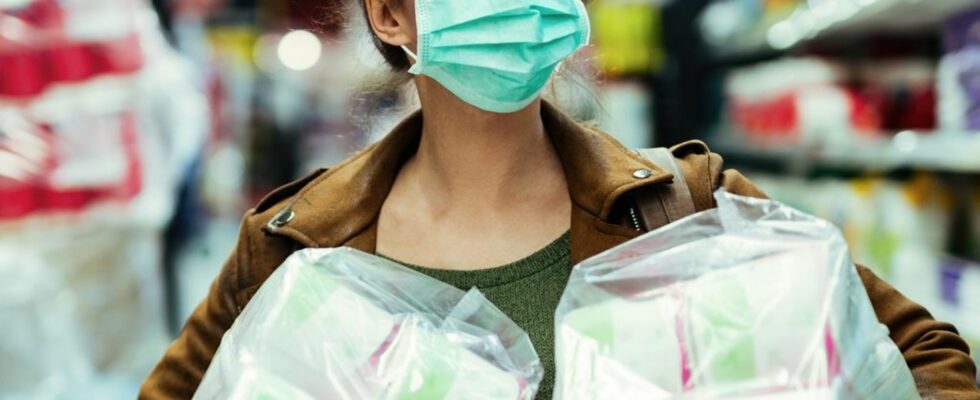Four years after the first Corona lockdown
Memories of the beginnings of isolation in March 2020
Toilet paper was in short supply on German supermarket shelves in March 2020.
© Drazen Zigic/Shutterstock
The first Corona lockdown began in Germany four years ago: looking back at a time that already seems surreal to us today.
This week marks the fourth anniversary of the start of the first Corona lockdown. On March 22, 2020, numerous restrictions in public life came into force and suddenly terms such as contact bans, hygiene measures and incidence values became an integral part of our everyday lives. It was normal to find empty shelves in the supermarket when you really needed toilet paper, and hashtags like #stayathome or #flattenthecurve were common words on social media, calling on us to voluntarily go into isolation.
These regulations and consequences of the first Corona lockdown were part of our everyday lives at the time:
1.5 meters distance, ban on contact, curfew
There are still signs hanging in supermarkets, restaurants and other public places that point out that it is necessary to keep a distance from one another. During the Corona period, it became common practice to keep a distance of at least one and a half meters from other people. During the lockdown it was even said by the Federal Government on March 22, 2020: “Staying in public spaces is only permitted alone, with another person who does not live in the household or with members of your own household,” contacts must be “reduced to an absolutely necessary minimum.” In Bavaria, a curfew was even imposed from March 20th. Even going for a walk was forbidden. Unless you had a dog.
What counted were numbers, numbers, numbers: looking at the daily infection levels became a regular everyday ritual as the Corona period became longer and longer. Ultimately, the all-determining regulations were linked to the respective incidence value. Such as school closures, exit or access restrictions.
Schools and daycare centers were closed. Parents and children were no longer allowed to be in playgrounds. Private celebrations, meetings and events in cultural institutions were prohibited. No one was allowed to spend the night in clubs, bars and discos anymore. Cafés and restaurants remained empty. “We stay at home” was the motto, which numerous celebrities also called for on their social media channels. Like Arnold Schwarzenegger (76) on his X channel.
A new hairstyle was not systemically relevant
Suddenly it was important for your own profession whether it could be classified as “systemically relevant”. The lockdown hit hairdressers particularly hard, for example, as they suddenly could no longer go about their business. To do this, we all learned to cut or dye our own hair. Back then, celebrities couldn’t help but say goodbye to their otherwise always top-styled hair and, if in doubt, lend a hand themselves – with more or less great success. Like influencer Riccardo Simonetti (31) with his eyebrow fail on Instagram showed.
That was the Germans’ panic buying
Other people’s panic purchases became a threat when shopping in the supermarket: the most sold-out items in Germany were toilet paper, pasta, flour, disinfectant and soap. “I don’t think I’ve ever washed my hands so often in my life,” said rock star Alice Cooper (76), summing up the situation at the time almost a year later in February 2021 in an interview with the news agency spot on news. “But I saw the whole world doing that and I said, ‘Well, let’s work together and beat this thing.'” 2020 will “go down in history as perhaps the strangest year ever.”
Home office, online yoga and banana bread
In 2020, we got used to previously strange things like home office with numerous video conferences, home schooling, online yoga and tons of banana bread that everyone suddenly posted on their Instagram Stories. We got to know the sky without planes and were amazed by news of crystal clear water in the canals of Venice, to which sea creatures suddenly returned after man had disappeared from it.
However, visiting Venice itself was not possible: the Robert Koch Institute put lists of risk areas online. Anyone who traveled anyway had to expect two weeks of quarantine. Border controls with temperature checks became a reality. Transitions from state to state were also difficult. However, always there, no matter where, was the obligatory mask for the “mouth and nose covering requirement”, which became part of everyday life with the first lockdown. First in the form of self-sewn copies in a wide variety of colors and finally in the form of surgical and FFP2 masks.
At the beginning of the pandemic, few could have imagined that they would only slowly disappear from the normal cityscape almost three years later. At the beginning, many naively assumed it would take weeks rather than years. But after the first easing on May 4, 2020, after a somewhat more relaxed summer, the next lockdown closures didn’t take long to arrive…
